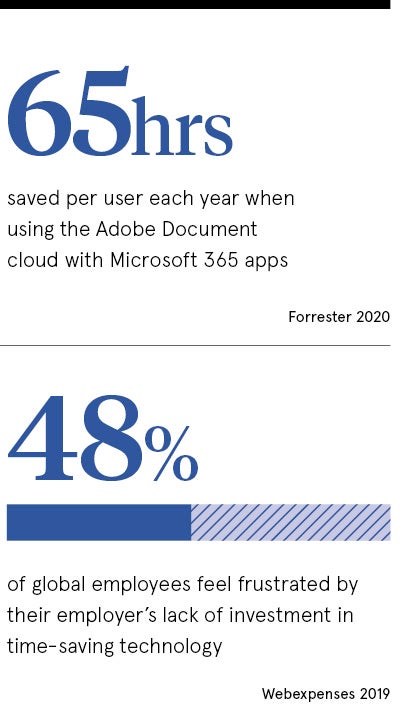Since the coronavirus lockdown, digital tools such as Zoom and Microsoft Teams have rocketed to the top of the business agenda, playing a crucial role in keeping people connected. However, there are numerous other tools organisations are relying on to help their workforce while working remotely.
Julie Berry, IT partner at accountants Saffery Champness, says her firm put a cloud-first strategy in place prior to the pandemic in a bid to increase agility. To kick-start this strategy, the company required a new document management system and it immediately looked for cloud-based products rather than on-premise alternatives, which she believed were far too slow.
“The two key criteria were we wanted something that could manage our email and ensure everyone in the firm could find the relevant document they needed,” she says.
People were relying on where they had saved a document on a system to track it down from the company’s server, so Saffery Champness required a product which enabled staff to search for a document. After a thorough trawl, the company decided to opt for NetDocuments.
“It has been hugely helpful since lockdown, because it means our employees can work from home and, as long as they have access to the internet, they can access the document management system,” says Berry.
Different employees need different tools
This has also helped reduce the pressure on the firm’s VPN (virtual private network) bandwidth, as employees no longer have to connect to the company’s servers to access files.
Nick McQuire, vice president of enterprise research at CCS Insight, says VPNs have only been designed for around 20 per cent of most workforces. “One firm I spoke to had to consider encouraging workers to work at different times of the day to ease the constraints on its VPN,” he says. 
CCS Insight has seen a 100 per cent increase in the use of document-sharing and collaboration applications during the pandemic. But there’s clearly reliance on tools other than video conferencing. Different employees will require different types of tools to help them work remotely, and it’s up to organisations to make sure these tools can be deployed securely and without pressure on VPN bandwidth, says McQuire.
Multinational law firm King & Wood Mallesons has recently migrated to the iManage Cloud. Darren Brown, head of IT in Europe and the Middle East, says this has helped with working from home, maintaining performance and response times, and avoided VPN bandwidth issues, which may have arisen if the company’s network and systems had not been cloud enabled.
“iManage is an essential tool for our lawyers, providing a complete electronic file. It is therefore essential the platform is accessible when working remotely to service our clients’ needs at all times,” says Brown.
“With iManage Cloud this access is achievable with an internet connection and no complex needs for a VPN, ensuring everyone is able to see and work on the most recent and most relevant information as it is needed.”
Microsoft services top of remote lists
The law firm also uses Microsoft Intune to push applications to mobile phones, including the iManage Document Management System, Microsoft Office 365, Microsoft Teams, Elite Finance System, Microsoft Authenticator and an annual leave booking system.
“These tools ensure we are able to provide a secure, performant environment that replicates the user experience when in the office, including telephony, without complex redirection of calls, time-recording and matter management,” says Brown.
“As the majority of the application suite is cloud based, the Microsoft product set integrate seamlessly with each other and other products via single sign-on and has required only a small amount of additional training, enabling the lawyers to focus on our clients and IT to continue working on business-as-usual activities.”
Integration with Microsoft Office 365 or other key email applications is one of the main areas organisations seem to be striving towards to help with remote working, while also gaining other long-term benefits.
For instance, analyst firm Forrester interviewed Adobe Document Cloud and Microsoft Office 365 customers and calculated the potential return on investment of integrating the two applications would be £7.4 million over three years. Customers said they saved time and costs in areas including digital enrolment, printing, delivery and governance.
E-signature products that enable quick, easy and secure consent capture are key to these benefits. Forrester found that Adobe Sign saves £5 and 1.5 hours per transaction, and around £444,000 in annual paper costs.
How remote tech sped up paperless
Added benefits of integration during remote working are that employees don’t need to print off copies of documents unnecessarily or spend time scanning signed letters; some employees may not have access to printers or scanners at home. In addition, clients are more likely to respond swiftly if they can sign documents electronically.
Developers at Rest Less, a website dedicated to helping over-50s, use a number of tools to help while staff are working remotely. These include Atlassian’s Confluence, a collaboration software programme, and Atlassian’s Jira, a software development tool.
One firm I spoke to had to consider encouraging workers to work at different times of the day to ease the constraints on its VPN
“We were using these before the pandemic as we already had some remote teams so, while others may use a board and post-it notes and things like that, we have Jira which we share as a way to track progress,” says Rest Less co-founder and chief technology officer Sara Stephens.
Since the lockdown, the team has missed whiteboarding and so has started to use diagram software Draw.io and screen-sharing with Google Meet, which has helped replicate personal interaction and enables creation of flowcharts and process diagrams.
Steve Clarke, senior manager of communication channels at Virgin Atlantic, says the airline deployed Workplace from Facebook’s Knowledge Library to keep employees informed about COVID-19. “We use it to provide details on government regulations as well as specific policies and frequently asked questions related to Virgin Atlantic,” he says.
Different employees need different tools

